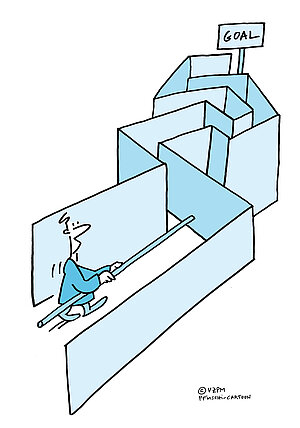Governance, structures and processes
Definition
The governance, structures and processes competence element defines the understanding of and the alignment with the established structures, systems and processes of the organisation that provide support for projects and influence the way they are organised, implemented and managed. The governance, structures and processes of an organisation may comprise both temporary systems (such as projects) and permanent systems (such as programme and portfolio management systems, financial/administrative systems, supporting systems, reporting systems, and decisionmaking and auditing systems).
Sometimes these systems can even form the strategic reason for a project, for example, when a project is initiated for the purpose of improving business processes or establishing new systems.
Purpose
The purpose of this competence element is to enable the individual to effectively participate in and manage the impact of governance, structures and processes on projects.
Description
Structures and processes are an essential part of the governance system of any organisation. To align with structures and processes means the ability to utilise value systems, roles and responsibilities, processes and policies established in an organisation to ensure that projects achieve their objectives and strategic corporate goals. To manage projects in line with the established organisational structures and processes requires a basic understanding of the various types of initiatives and how a project-oriented organisation works, as well as the benefits associated with management by projects. It includes the alignment with permanent processes related to the management of the project. Most project-oriented organisations have various types of supporting structures and processes for projects. In the domain of project management, the individual may be called upon to provide data and business intelligence to the governance process and to work within existing structures and processes. Some projects may result in changes to structures and processes.
Examples of supporting structures and processes are line functions such as human resources (HR), finance and control and information technology (IT). Mature project organisations may also provide more dedicated support to project management through a project management office (PMO).
To be competent in structures and processes also means the ability to review and apply feedback and lessons learned from previous projects. A key challenge is to balance the use of compulsory and optional structures and processes for optimal effect and benefit to the project.
Key competence indicators
Know the principles of project management and the way in which they are implemented
The individual reflects the concepts of a project and management by projects and can explain the difference between different types of organisation settings (e.g. functional, matrix and project-oriented organisation), and knows how to optimally align performance with the current organisational setting. The individual can explain the characteristics and principles on which management by projects is based and is able to set up a project-oriented environment. Furthermore, the individual is aware of the maturity concept of the project-oriented organisations covering organisational competences, project and programme competences, and individual competences.
Measures
- Recognises a project in practice and has a knowledge of project management principles
- Explains characteristics of a functional, project and matrix oriented organisation and recognises one in practice
- Explains and practises the concept of management by projects
- Perceives and sets up management by projects concepts within the organisation
- Explains and identifies the current maturity level of an organisation
Know the principles of programme management and the way in which they are implemented
If the project is part of a programme, the individual has to align the project with the programme and has to know how the principles of programme management are implemented in the specific organisation. The dependencies between the project and the programme as well as between the different projects within the programme have to be analysed in terms of input, goals, outcomes, etc. Dealing with those dependencies means setting up and maintaining interfaces between the project and the programme.
Measures
- Explains characteristics of a programme (goals, inputs, outputs, outcomes, benefits)
- Explains the concept of programme management
Know the principles of portfolio management and the way in which they are implemented
The individual knows the way in which portfolio management is implemented in the specific permanent organisation. Therefore the individual knows the portfolio criteria and required inputs and outputs and identifies the impact of the project on the portfolio. The individual is able to discover different constraints within the portfolio and can take these constraints into account to harmonise resource utilisation of his or her project. The individual is able to filter and/or funnel the communication channels with the respective portfolio in order to positively influence the project performance. The individual knows the vertical (e.g. with the programme or portfolio manager) and horizontal (e.g. with other individuals in the same programme other project teams) lines of communication as part of the overall coordination process with a programme or portfolio.
Measures
- Explains characteristics of a portfolio – critical success factors (CSFs) and key performance indicators (KPIs)
- Knows the concept of managing a portfolio (organisational structures and processes)
- Successfully communicates within a respective portfolio in order to successfully manage a project
Align the project with supporting functions
Project supporting functions (a project office, a project management office or similar) provide multifaceted support to the project and/or the individual managing the project in relation to organisation, planning, reporting, meeting management, documentation, etc. To ensure the necessary support from the project supporting function, the individual has to know relevant contact people within the project supporting function and how to establish and maintain good relationships with them.
Measures
- Knows people, processes and services of supporting functions
- Uses the project supporting function of the parent organisation for efficient support of the project
- Establishes and maintains relationships with the project supporting function
- Applies the reporting standards of the parent organisation to the project, using specific tools and methods
Align the project with the organisation’s decision-making and reporting structures and quality requirements
The success of a project is very much dependent on the right decisions made at the right level of the organisation at the right time. Every decision should be prepared, presented, accepted, recorded, communicated and finally implemented. Formal and informal routines and special rules for decision-making beyond the individual’s authority and responsibility exist in each organisation. Therefore, the individual requires knowledge of the decision-making structure and processes and the ability to structure and manage the project accordingly. Periodic reporting of the actual status is essential for trust by its stakeholders and to assure traceability of the progress.
Different project stakeholders have different reporting needs (information requirements, method of delivery, reporting frequency) which the individual has to take into account. The parent organisation will have different forms of quality assurance which relate to projects (e.g. system assurance, project assurance, finance assurance, technical assurance, security assurance, etc). For the individual it is important to take these into account in devising a quality assurance plan for his or her project, to decide which project areas could become quality assurance objects and to know which members of the project team should be involved in project assurance activities.
Measures
- Identifies the organisation’s routine and special rules for decision-making in cases beyond his or her authority and responsibility
- Aligns the communication in projects with the needs of the permanent organisation
- Applies the reporting standards of the parent organisation to the project, using specific tools and methods
- Applies the organisation’s way of quality assurance when setting up a reporting system within the permanent organisation
Align the project with human resource processes and functions
The human resource function provides multi-faceted support to the project in relation to team member contracts, temporary employment, training, salaries, incentives, stress, wellbeing, ethics and team entries and withdrawals. A well-established relationship with the human resource processes and functions may increase the influence on resource availability and quality in terms of adequate authorities. To ensure the necessary support from the human resource function, the individual has to establish and maintain relationships with relevant contact people within it.
Measures
- Uses the human resource function for acquiring staff with the required authorities
- Deals with the boundaries between the temporary organisation and the human resource function
- Establishes and maintains relationships with the human resource function
- Uses human resource processes to provide training and individual development
Align the project with finance and control processes and functions
The finance and control function of an organisation is often established as a line function providing mandatory rules, procedures and guidelines. Knowing these rules and how to utilise them effectively and efficiently are crucial for the individual for successful funding, monitoring and/or reporting on financial topics. The finance and control function of an organisation often serves as a support function, offering a variety of utility functions for the individual such as how to apply for, justify, manage and report on financial resources and how to administer, distribute, monitor and manage finances. The individual needs to know various financial models for funding (e.g. public, private, public-private partnerships, subsidies, commercial, etc) endorsed by the permanent organisation. To ensure the necessary support from the finance and control function, the individual can benefit from establishing and maintaining relationships with the relevant contact people within the finance and control function.
Measures
- Knows the processes of the finance and control function
- Distinguishes between the compulsory and optional utilities of the finance and control function
- Monitors and controls whether rules, guidelines and other financial utilities are effectively and efficiently used in projects to the benefit of the project
- Communicates and reports the status and trends of financial tasks clearly and objectively


